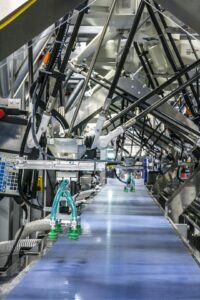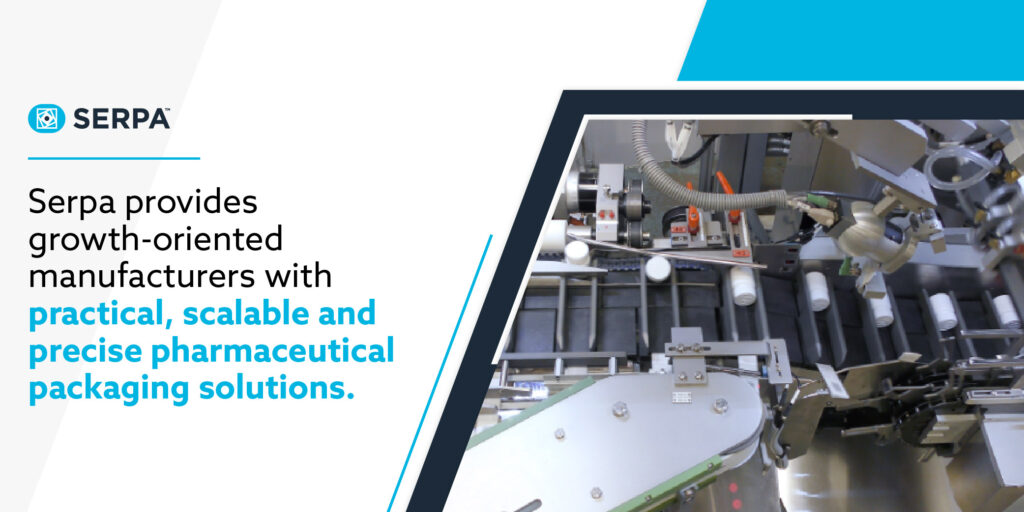
It’s a tough time for manufacturers. Broad spectrum supply chain issues and labor shortages, combined with industry-specific pressures like regulatory compliance and rising demand, have many pharmaceutical companies looking for solutions.
Robotics integrated into cartoning, case packing, sleeving, and palletizing systems can transform pharmaceutical packaging operations, providing relief for businesses facing industry pressure to deliver safe, accurately packaged products quickly and precisely.
When properly deployed, robotic pharmaceutical packaging equipment helps businesses meet demand, manage brand image and protect products and consumers.
Industry Challenges Driving Robotic Adoption in Pharma Packaging
Margins in the pharmaceutical packaging market are increasingly narrow, making efficiencies a crucial part of any pharmaceutical company’s strategy.
Robotic adoption allows companies to meet industry challenges head-on, creating robust production systems to help them adapt and thrive in an ecosystem that requires precision and flexibility.
Stringent Regulatory Requirements
The FDA and GMP have stringent standards for pharmaceutical product packaging. When met, these regulatory requirements mitigate contamination risks, ensure traceability and maintain consumer trust in drug safety.
Robotic systems reduce contamination risks and other compliance errors by reducing human interference. They also ensure that vital information, such as expiration dates and lot and control numbers used for batch tracking, is clearly and securely marked on all products.
Finally, integrated visual systems automate quality checks by inspecting labels, verifying tamper bands and ensuring proper orientation.
Product Sensitivity and Safety
A pharmaceutical packaging machine does not get tired or distracted like a human employee. It always applies consistent pressure and movement when handling fragile or sensitive products like vials, blister packs, ampoules, and syringes.
Labor Shortages and Operational Costs
According to Pharmaceutical Commerce, robot-integrated pharmaceutical packaging machines can save businesses up to 50% in labor and operational costs. These systems allow companies to reduce their workforce, increase throughput and minimize downtime.
Systems with modular design and tool-free adjustment enable simultaneous tasks and allow rapid changeovers for varying products, sizes and complex packaging formats.
Key Robotic Packaging Technologies Benefiting Pharmaceutical Operations
Modular design makes it simple to network multiple pieces of pharmaceutical packaging machinery to create a complete system tailored to your business’s packaging and labeling needs.
Robotic Cartoners
The essential function of robotic cartoners is to form chipboard blanks, load the cartons with the product, and fold and seal the carton flaps. Robotic cartoners improve output and can handle a wide range of carton sizes and product types. Benefits include:
- Precision handling of sensitive pharma products
- Integration of serialization and inspection systems
- Efficient changeovers for multiple stock-keeping units (SKUs)
Robotic Case and Tray Packing Solutions
Robotic case and tray packing solutions automate the loading of products into cases or trays. These flexible systems can handle over 1,000 products per minute. Benefits include:
- Gentle handling of vials, tubes, blister packs, and cartons
- Layer forming and collation for maximized case density
- Ensuring product orientation and accuracy with vision-guided robots
Robotic Palletizers for Pharma Packaging
These advanced, automated systems stack and arrange products onto pallets. Robotic palletizers follow preprogrammed stacking and layering patterns, increasing throughput, stability, and accuracy. Benefits include:
- Cleanroom-compatible robotic palletizing options
- Flexible recipe changes for multiple product lines
- Reducing human handling for safety and contamination control
Auxiliary Robotic Systems That Make a Real Difference
In pharmaceutical packaging, speed and precision are everything — and that’s where auxiliary robotic systems come in. These add-ons, like labelers and insert feeders, integrate seamlessly into your existing line to improve accuracy, boost throughput, and reduce manual intervention.
Take our TEL10 Tamper Evident Labeler, for example. It’s compact, easy to integrate, and built to move fast — up to 400 cartons per minute. Its positive traction roller ensures labels don’t skew, while quick-disconnect heads and optional automatic changeover make switching formats a breeze. It’s the kind of upgrade that keeps things secure without slowing you down.
Then there’s our High-Speed Automatic Insert Feeder. It’s designed to feed over 400 inserts per minute without needing constant attention from an operator. No gravity drops, no tricky tray loading — just positive, contained transfer from start to finish. Plus, it handles a wide range of insert types and tray sizes with minimal changeover time.
In short, these auxiliary systems help you move faster, stay compliant, and reduce headaches — all without overhauling your line.
Benefits of Robotics in Pharmaceutical Packaging
The widespread adoption of robotic systems is one of the most significant advances in pharmaceutical packaging. Automated packaging solves persistent, broad issues, and systems tailored for pharmaceutical businesses can also address industry-specific needs.
How robotic systems help:
- Improved accuracy and consistency
- Enhanced product safety and integrity
- Faster throughput and production flexibility
- Easier compliance with traceability and serialization
- Reduction in labor costs and risk of contamination
- Scalability for growing product portfolios
Although some businesses may hesitate due to upfront costs, the rewards of a well-designed, flexible and automated pharmaceutical product packaging system can help your company meet the needs of an increasingly demanding global market.
What to Consider When Adding Robotics to Pharmaceutical Packaging Lines
Understanding your business’s unique pharmaceutical packaging design needs is crucial before investing in a robotic system. These systems work best when tailored, allowing companies to achieve scalable, long-term growth.
Things to do when pursuing automation:
- Assess production volume and variability
- Understand cleanroom requirements and washdown capabilities
- Plan for system integration with serialization and inspection technologies
Choosing a partner experienced in pharmaceutical packaging automation gives businesses critical, expert support during this transition. Your system designer should bring expertise, understanding and creativity to your automation journey.
How Serpa Supports the Pharmaceutical Sector
Pharmaceutical manufacturers face an increasingly competitive and demanding marketplace. Labor shortages, supply chain issues and regulatory guidelines have narrowed margins to a sliver.
Serpa provides growth-oriented manufacturers with practical, scalable and precise pharmaceutical packaging solutions. We understand the unique challenges facing pharmaceutical businesses, and we build our machines to meet them.

Our cartoners, sleevers, case and tray packers, robotic palletizers, and auxiliary equipment are designed specifically for pharmaceutical use. Every piece of equipment is built to help you meet compliance guidelines, increase precision and boost operational efficiency.
Robotic pharmaceutical packaging services create savings and solve problems. Contact us to explore robotic solutions that meet your pharmaceutical packaging needs.
